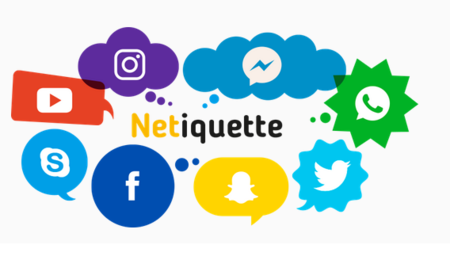Netiquette is manners for the Internet.
Netiquette deals with all behavior online. Whether it is posting on social media, answering a discussion post for a class, or sending emails, ; students will then use aspects of Netiquette. While the rules of Netiquette change often as new technology is created, the overarching theme remains the same: Be Kind. It is important for teachers and parents to teach children how to act online in a responsible and safe way.
The video below explains the core rules of Netiquette and is a great way to introduce yourself to the concept.
Core Rules of Netiquette from Angel Rivera on YouTube.
Before you post online, THINK.
Is it true? You do not want to post inaccurate information online. People could read it and think it was true.
Is it helpful? Is it inspiring? If what you want to post is not going to help or inspire others, maybe you should not post it.
Is it necessary? The internet is already filled with so much information. If your contribution is not necessary, then do not post it.
Is it kind? This is perhaps the most important question of all. Just because you post from behind a screen does not mean you are allowed to be mean. Make sure your online contributions are kind to others.
 |
| Image Credit: Thomas Galvez |
Of course, you must consider the type of online activity that you are doing. Posting on social media, answering a discussion post for a class, and answering a work email all require very different types of behavior. Make sure to think about what you are doing online and how you need to act according to that activity. However, using the THINK acronym can be helpful in every type of online activity.

Beverly Hills Unified School District shares 10 Netiquette rules for students and parents. These rules are straight-forward and a way to make sure that students are interacting appropriately online in a way that will keep them safe, teach them to be kind online to others, eliminate cyberbullying, and enhance the educational implications of using the Internet. For parents, these 10 rules keep them accountable in making sure their children are being safe and kind online. Teachers should make sure students and parents are aware of these Netiquette rules, as well as any specific classroom rules that apply to using the Internet. Teachers should review these rules with students and parents regularly.
These rules are especially important as online learning has become more popular due to COVID-19. Since some students are learning from home, it is important for them to be aware of how to responsibly and safely use the Internet as a learning resource. Parents, as the primary monitor for these children's online behavior, must check in with their children at home to make sure they are following these rules and the rules set in place by their children's teachers.
Here is an additional video on some basic Netiquette tips. This video would be beneficial for teachers to share with students when first introducing the idea of Netiquette and periodically as a reminder throughout online learning activities.
Netiquette from Pamela Karon on YouTube.
Lastly, Cyberbullying is just as hurtful as bullying in real life. People sometimes feel more confident from behind a screen and can say or do mean things. It is important for students to understand that their actions online have consequences. It is also important for teachers and parents to understand how to help their students and children if cyberbullying occurs. This video helps show how cyberbullying can hurt someone's feelings and the consequences that go along with it.
How to deal with CYBERBULLYING from gaiabian08 on YouTube.
Additional Resources:
- What is Netiquette?
https://whatis.techtarget.com/definition/netiquette
- Netiquette for Kids
https://www.bpl.org/kids-learn/netiquette-for-kids/
- Tips to Help Stop Cyberbullying
http://www.connectsafely.org/tips-to-help-stop-cyberbullying/
